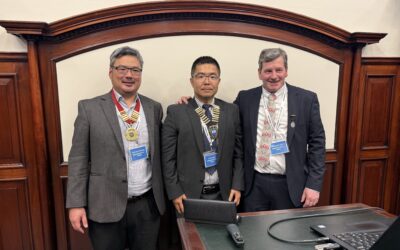Corrosion Science Division (CSD)
The 63rd Corrosion Science Symposium (CSS) again joined the Electrochem meeting, which was hosted by the University of Edinburgh between the 4th and 6th September. Electrochem is an annual meeting organised jointly by the RSC Electrochemistry Group and the SCI Electrochemical Technology Group. There were 21 oral talks and the UR Evans award plenary talk, plus a dozen posters over the two days.
The U.R. Evans award for 2022 was presented to Prof Alison Davenport (University of Birmingham, UK) by Stephen Tate (ICorr Vice President) at the 63rd CSS. In her plenary talk entitled ‘Passivation vs. Active Dissolution’, Alison explored how the shape and stability of localised corrosion sites are determined by the delicate balance between passive film growth and metal dissolution. The plenary focused on the nature of passive films and localised corrosion sites, and how they can be successfully explored in situ using a variety of synchrotron-based characterisation methods.
The Lionel Shreir Award is given to the best student presenter at the annual Corrosion Science Symposium, and this year was presented to Alyshia Keogh (University of Manchester). Alyshia gave a fascinating and insightful talk entitled ‘effect of microstructure on localised corrosion and atmospheric stress corrosion cracking of 15-5 precipitation hardened stainless steels, linked to understanding of pitting and atmospheric chloride-induced degradation associated with microstructural features effected by the ageing temperature (see summary of Alyshia’s presentation below). Alyshia commented that she enjoyed the interaction between academics, industry specialists and students at the CSS, and thought the symposium was especially stimulating with an excellent range of presentations and posters from many Universities, and she hoped to attend next year!
Effect of Microstructure on Localised Corrosion and Atmospheric Stress Corrosion Cracking of 15-5 PH Stainless Steels
Alyshia Keogh, Anthony Cook, Emily Aradi, Alex Wilson, Fabio Scenini, Phil Prangnell, University of Manchester, and Zacharie Obadia, Airbus, Toulouse, France.
This work aimed to enhance mechanistic understanding of pitting and atmospheric Cl-Induced Stress Corrosion Cracking (AISCC) in 15-5 Precipitation Hardened (PH) Stainless Steels (SS) by establishing links between microstructural features affected by varying ageing temperature (here, 450 C, 540 C and 650 C) and susceptibility to such phenomena. This microstructural evolution, as a function of ageing temperature, was investigated via scanning TEM energy dispersive X-ray spectroscopy (STEM EDS), and differences in environmental behaviours assessed using both electrochemical and environmental testing under controlled conditions of temperature and Relative Humidity (RH). Statistical scatter in pitting potential determined via potentiodynamic polarisation was too high to determine any trend in localised corrosion resistance with confidence. However, useful information was obtained via Double Loop Electrochemical Potentiokinetic Reactivation (DL-EPR) and Electrochemical Noise (EN) measurements. DL-EPR revealed a linear trend between the degree of sensitisation and ageing temperature which correlated with an increase in number density of Cr carbides. EN measured by galvanically coupling dissimilar microstructures suggests that the highest temperature ageing treatment (650 C) was most susceptible to metastable pitting events and, hence, has a higher probability of transitioning to stable pitting.
AISCC tests (four-point bend specimens with Cl-salt deposits exposed to controlled temperature and RH) revealed that over-aged specimens (ageing temperature 650 C) were most resistant to cracking, whilst EN indicated they had greatest susceptibility to pitting. The opposite was found for under-aged specimens (ageing temperature 450 C). The mode of AISCC transitioned from an intergranular (IG) pathway in under-aged specimens (450 C) to mixed IG and transgranular (TG) for those peak-aged (540 C), no cracks were observed under the same testing conditions in over-aged specimens. Overall, these results are consistent with the theory that AISCC, like conventional SCC, only occurs under conditions of slow and stable localised corrosion.



